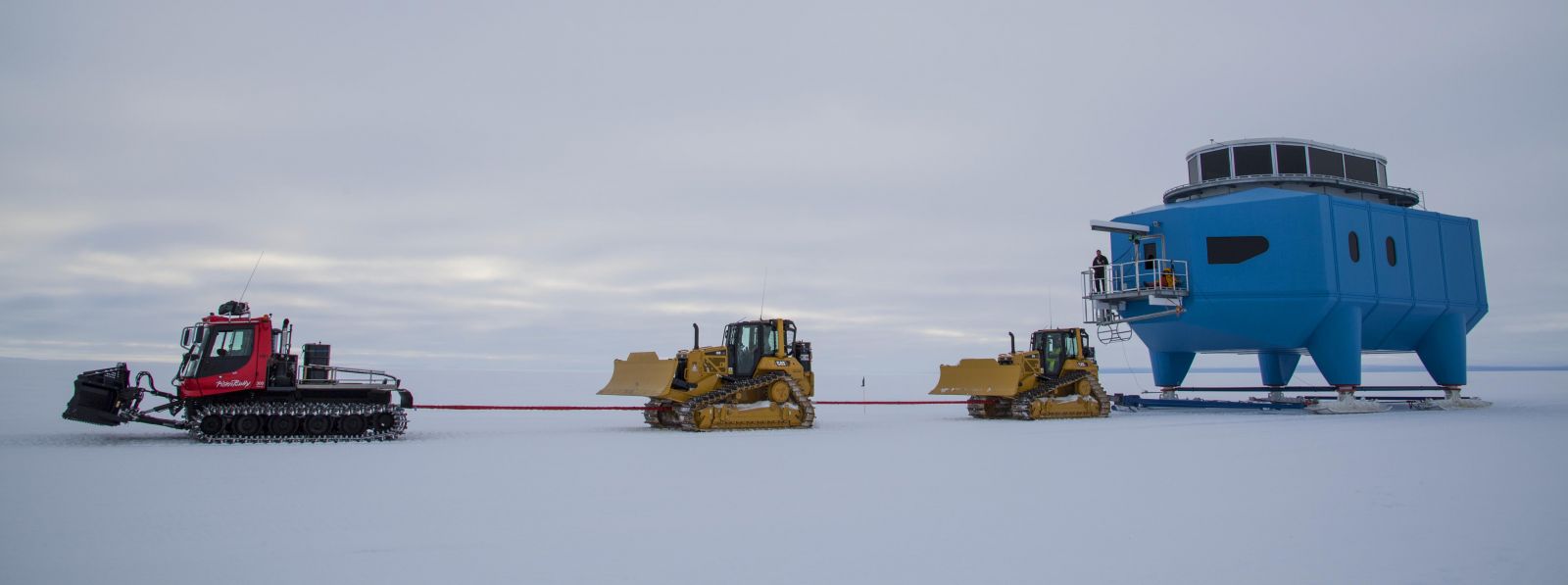Strainstall's Equipment Supports Relocation Project in Antarctica
• Strainstall’s specialist technology used for prestigious BAS Halley VI relocation project
• Extreme temperature shackles provided load data during towing operations of Halley VI modules
• Load monitoring solution ensured safety and efficiency of project, and also appeared in the BBC Horizon documentary
Strainstall, part of James Fisher and Sons plc, is extremely proud to announce it has supplied specialist load monitoring equipment to the British Antarctic Survey (BAS), to support the Halley VI research station relocation project which recently took place, by ensuring safe operations.
The Halley VI research station, located on the Brunt Ice Shelf in Antarctica, is an internationally important platform for global earth, atmospheric and space weather observation in a climate sensitive zone. Due to uncertainty over a newly developed crack in the ice shelf on which it sat, the British Antarctic Survey announced that Halley VI would be relocated 23km away, to ensure its continued safe operation in the future. Halley VI is the world’s first fully relocatable research station, made up of a series of eight pods that have been built upon huge hydraulic skis, so that it can be moved using specialist heavy vehicles to avoid calving events as the floating ice shelf moves towards the sea.
Although designed specifically for this reason, the relocation project was the first time the station had ever been moved, so three years of meticulous research and planning ensured the project was safety undertaken and ultimately was a success.
Strainstall supplied BAS with its specialist extreme temperature load shackles, along with Scotload’s innovative SmartLoad™ wireless technology, to deliver load monitoring information during the relocation, ensuring the safe towing of all the modules. To verify Strainstall’s specialist load shackle performance in sub-zero temperatures testing was undertaken down to minus 40 degrees Celsius, as this was the lowest temperature BAS confirmed that any operations would go ahead.
“The most critical part of the relocation project was the towing operation.” Explained Ben Norrish, head of vehicles engineering from the British Antarctic Survey.
“We needed to monitor the loads being applied to the modules by the towing vehicles. The Strainstall team supported us to find the best solution for the extreme conditions of the Antarctic. We had a limited time window so reliability of the equipment was critical to us.” He added.
Specifically designed for use in harsh environments, Strainstall’s extreme temperature load shackles are especially modified to provide reliability and high accuracy in extreme sub-zero conditions, as was demonstrated on this prestigious project. Using Scotload’s innovative SmartLoad™ wireless technology, the load monitoring information was fed directly to the relocation team in real-time during towing operations, to ensure safety and efficiency as they towed all of the Halley VI modules along the identified safe route. In addition to the live support, the data logging capability enabled the data to be stored and later analysed to help with any potential future relocations.
“The Strainstall shackles worked perfectly for all of the towing operations, providing operation critical data to the team and enabling a smooth relocation of the station within the timeframe so we were delighted with the outcome.” Concluded Ben Norrish.
Simon Everett, managing director of Strainstall said: “We were thrilled that our shackles were able to provide information to enable a safe and successful relocation of the Halley Research Station. This experience underlines the value of our engineering expertise in providing customers with solutions for challenging applications, where first time success is critical. In this case there was only one opportunity to get the equipment to the project so any failure of the equipment during the operation could have had serious implications. The extensive testing performed by the team verified the suitability of the shackles operating in an extremely cold environment and we are proud of the part we were able to play in the very successful relocation.”
This significant project was also recently a BBC Horizon documentary ‘Antarctica Ice Station Rescue’ which was first broadcast at 21:00 Wednesday 7 June, as BAS invited BBC film-maker Natalie Hewit to document the extraordinary process, dubbed the world's most extreme moving job.
Currently in the depths of an Antarctic winter, BAS decided not to over-winter at the Halley VI station as a precautionary measure, before its staff go back in October for the Antarctic summer season. Halley VI Research Station provides vital information for a global understanding of space weather, ozone depletion, polar atmospheric chemistry, sea-level rise and climate change. Current projects include long-term meteorology and ozone monitoring; Glaciological monitoring of the Brunt ice shelf; and SPACESTORM - a collaborative project to model space weather events and find ways to mitigate their effects on satellites.

The products and services herein described in this press release are not endorsed by The Maritime Executive.
